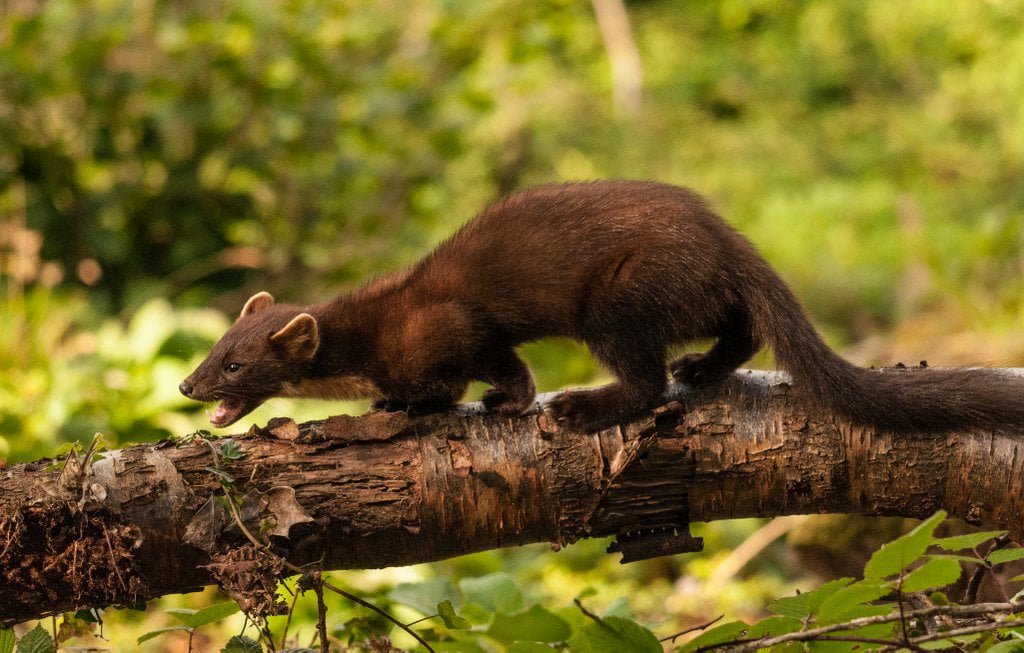
There are two squirrel species found in Ireland. The native red squirrel, Sciurus vulgaris, and the invasive North American grey squirrel, Sciurus carolinensis. In Ireland, the UK and Italy the grey squirrel threatens the survival of the red squirrel as the effects of competition and disease from grey squirrels almost inevitably lead to total replacement of the red squirrel population.
In 2007, the results of a national squirrel survey suggested that the normally invasive grey squirrel population in the midlands of Ireland may have begun to decline. This was a most unusual suggestion because whilst occasionally grey squirrel introductions have failed elsewhere, such a decline in range has not been recorded anywhere else for this species subsequent to having established itself as an invasive population. In the 2007 report, the decline in grey squirrel range was anecdotally attributed, by foresters and gamekeepers, to an increase in European pine marten, Martes martes, range and numbers. The pine marten population in Ireland had reached a nadir in the early 20th century as a result of habitat loss and persecution, but studies have found the core population in the west and midlands of Ireland have recovered in recent decades.
The 2007 survey recommended the theory that the pine marten population may be involved in the decline of the invasive grey squirrel’s range be investigated. So in 2009, funded by a scholarship from the Irish Research Council, I embarked upon a fascinating study investigating the role, if any, of the European pine marten in red and grey squirrel population dynamics in Ireland.
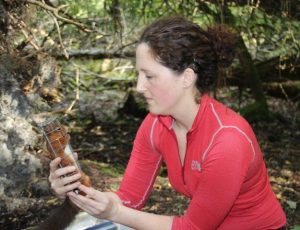
First of all I examined the distribution of all three species in counties Laois and Offaly in the midlands, where this phenomenon had been reported, and also in county Wicklow in the east, where all three species were also present but the grey squirrel range was not suspected to have gone into decline. I carried out detailed distribution studies by means of sightings and hairtube surveys, and at sites that were identified as being of particular interest, I carried out live-trapping programs to look at red and grey squirrel population demographics in detail. The results of my pine marten diet and abundance study were published in the European Journal of Wildlife Research last October and the impact of the pine marten’s recovery on red and grey squirrel dynamics have just been published in Biodiversity and Conservation. They are both available online for those who are interested in the details so I won’t go into too much detail here other than to say that the grey squirrel is not doing well at all in Laois or Offaly and in fact many of the surrounding counties have seen the invasive squirrel species decline dramatically in recent years too. Squirrel numbers fluctuate annually in relation to the previous year’s autumn crop and winter temperature, and it is absolutely normal to have good years and bad years, however what I have recorded is far beyond what would be expected during normal population fluctuations.
Another highly unusual result, which has come about as a consequence of the sustained reduction in grey squirrel numbers and range, is that red squirrels are doing very well in Laois and Offaly, and also in North Tipperary. They have also started recolonising parts of county Longford, Westmeath, north Kilkenny and even north west Kildare. Considering that red squirrels had been absent from much of these regions for several decades, and grey squirrels had once been abundant as far west as the river Shannon, this new squirrel distribution is a fascinating discovery, and certainly not what any squirrel expert would have expected to find!
However, it is also important to remember that this phenomenon is only occurring in some parts of Ireland. Grey squirrels continue to thrive in other parts of the country, including much of the east, and a recent study by Emily Goldstein in UCC has confirmed the grey squirrel continues to expand into the south west of Ireland.
So where does the pine marten come in to the picture?
In order to quantify the difference in pine marten abundance between areas that grey squirrels are doing well and those they are not, I used DNA analysis to differentiate between individual martens from hair samples I collected at baiting stations across a number of different sites. Colleagues in Waterford IT have optimised these techniques in the lab in recent years and with their guidance I learnt how to analyse DNA from pine marten hair samples and also from their scats which enabled me to establish with confidence how many pine marten there were at each site, and also, interestingly, what mammals they were eating.
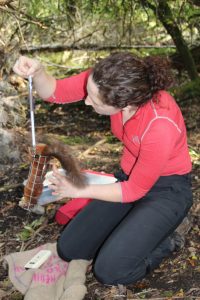
Where pine marten (and their scats) are plentiful, red squirrels have recovered and are living side by side with their natural predator. My dietary study confirmed what numerous other studies have before me: that is, pine marten do eat red squirrels, but not very often! On the other hand, grey squirrels had either disappeared or were incredibly rare in areas that pine martens were abundant, and so in order to determine whether they will eat grey squirrels when they are on the menu, I had to search really hard for sites that grey squirrels were living in normal numbers and pine marten were also present too. Interestingly I could only find this overlap at sites where pine marten numbers were very low. Indeed I had to use the help of a specially trained scent detection dog to build up a decent sample size of scats in these areas. Eventually, I recorded the first evidence of the European pine marten predating upon the North American grey squirrel in Tomnafinnoge wood in Wicklow, and indeed grey squirrels featured about 8 times more frequently in scats than red squirrels did, in the areas that they were on the menu at all. Which makes sense, considering they live in much higher numbers than red squirrels, and would therefore numerically be much more available.
However, the most interesting observation of all was this negative correlation between pine marten and grey squirrel presence at woodland level, which was the cause of the relatively small sample size of scats. This negative correlation in distribution also suggested that the non-lethal effects of an abundant predator population may be influencing the grey squirrel’s ability to succeed as an invasive species in Ireland more so than direct predation itself.
The presence of a predator population can have a number of behavioural or physiological effects on prey species, and this is a subject that has been widely studied by mammalogists worldwide. The many effects that have been found to occur include stress-induced reduction in breeding activity, suppressed immunity, changes in foraging behaviour and shifts of habitat to avoid the risk of predation. When predator and prey have co-existed or co-evolved together, predation does not tend to occur at a level that negatively impacts the prey species in the long term, as they have co-adapted to survive over time. Indeed predators are a vital part of a healthy ecosystem and predator prey interactions have an important function. However when either predator or prey species are non-native, and they have not evolved a natural relationship with each other, the effects of predation on one or both of the species can be quite dramatic. In the case of the alien American grey squirrel and the native European pine marten, it will be difficult to figure out exactly what is going on because of this negative association that exists between the two. Therefore, because of this difficulty in finding the two species at the same site, their true relationship has yet to be established and there is an urgent need for funding more research on the subject.
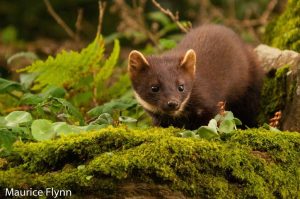
It would seem from the evidence gathered to date that the presence of an abundant tree-climbing predator may be the cause of the grey squirrels’ retraction from the midlands, and the native red squirrel’s subsequent recovery. Interestingly, I have recently met with foresters in Scotland, where the pine marten is also making a natural recovery, and they have informed me that in some parts of Scotland the same sequence of events has occurred in recent years i.e. when pine martens recover naturally, to healthy numbers, first grey squirrels disappear, and this is shortly followed by a red squirrel revival. The fact that what we have seen happening in Ireland may be being replicated naturally on a separate island is very encouraging news by all accounts, and plans are in place, pending funding, to further research this dynamic in the very near future!
It could be that as the pine marten continues to recover naturally in Ireland and in Scotland, the red squirrel will continue to take advantage of their American cousin’s apparent aversion to their tree-climbing predator. There is certainly cause for optimism for the until recently, much beleaguered red squirrel’s fate! Watch this space…!
The paper “Population crash in an invasive species following the recovery of a native predator: the case of the American grey squirrel and the European pine marten in Ireland” by Emma Sheehy and Colin Lawton is published in the current issue of the journal Biodiversity and Conservation.
To find out more about the Irish Squirrel and Pine Marten Project visit Emma’s Facebook Page here.


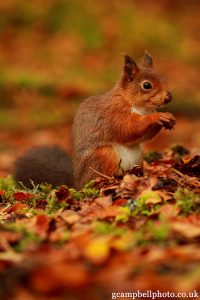







14 comments
brendan byrne
Great to see the return of the reds.Watched a family of 4 play in the woods beside my cottage in Glendalough Co wicklow yesterday
Aisling
I am currently watching two red squirrels in Templemore Town Paek Co Tipperary
Eleanor Rnonaghan
I have recently seen a couple of pinemartins in my garden
Jonathan Rice
What a fascinating and heartening article! I grew up seeing red squirrels all the time in West Dublin (70’s – 80’s), and it’s been so sad to hear of their seemingly inevitable decline in the U.K. and Ireland. It’s just wonderful to hear that reds still have a fighting chance, in some areas at least, but even more so because this seems to be due to a broader ecosystem coming back into balance. All is not doom and gloom in conservation! Thank you for your work!
Thomasina barron
Hi emma, I came across a little baby squirrel today…possibly my dogs startled a hawk away from it..it was still breathing but badly injured. I think it is a red squirrel rather than a grey? I have a photo. Not sure if i can attach it to this message. Location is bog land near knockanally golf club …lot’s of evergreen trees around.
Calvin Jones
Hi Thomasina… this isn’t Emma, but let’s see if I can help :-).
Your best bet for info on what to do with injured wildlife is to check out the Irish Wildlife Matters site. You’ll find all sorts on their — including how to determine if an animal needs help, how to care for injured animals, and contact details for wildlife rehabilitators and wildlife friendly vets around the country.
Best of luck with the casualty.
All the best,
Calvin!
Huw Sayer - Business Writer
Fascinating study – I had heard various anecdotal reports suggesting this relationship between reds, greys and martens but this this is the first time I’ve come across a scientific report that supports the idea. Thank you – will share on twitter.
michael shiell
Hi Emma, just to say there was a red squirrel on a tree in our garden on the Coliemore road, Dalkey, Co. Dublin this morning! Sat. 29th August 2015.